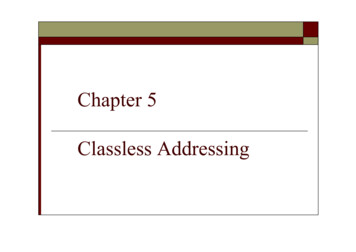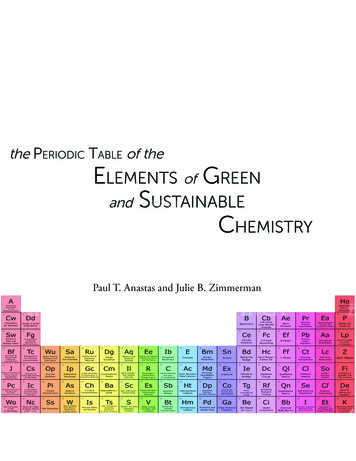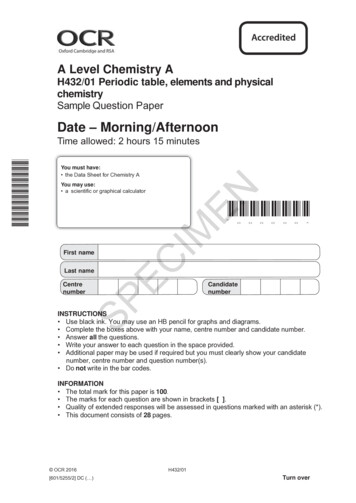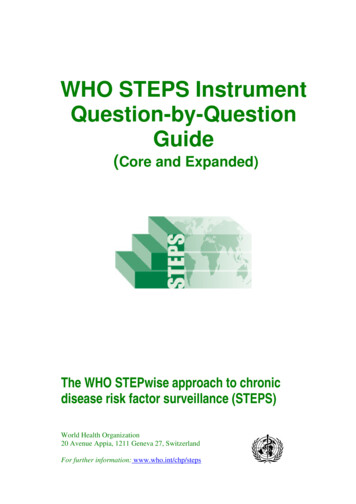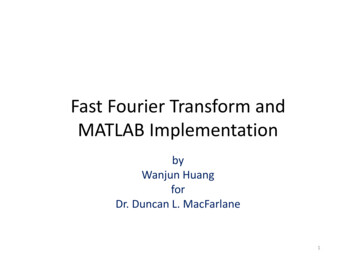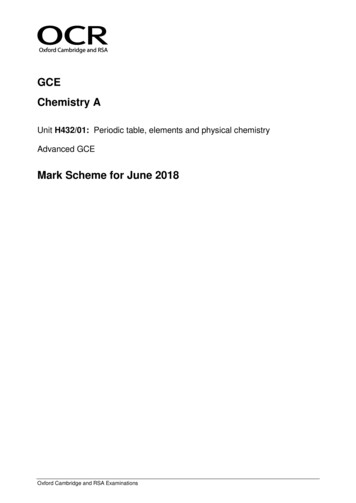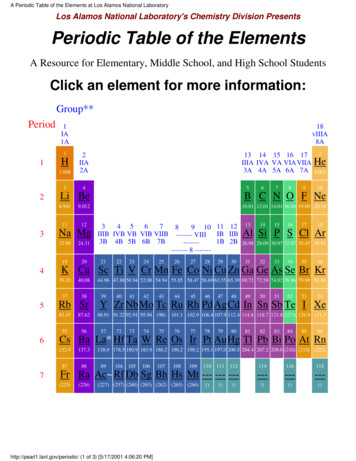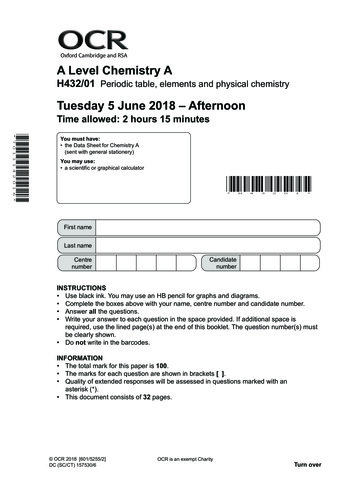
Transcription
Oxford Cambridge and RSAA Level Chemistry AH432/01 Periodic table, elements and physical chemistryTuesday 5 June 2018 – AfternoonTime allowed: 2 hours 15 minutes* 7 0 1 1 1 4 2 0 1 6 *You must have: the Data Sheet for Chemistry A(sent with general stationery)You may use: a scientific or graphical calculator*H43201*First nameLast nameCentrenumberCandidatenumberINSTRUCTIONS Use black ink. You may use an HB pencil for graphs and diagrams. Complete the boxes above with your name, centre number and candidate number. Answer all the questions. Write your answer to each question in the space provided. If additional space isrequired, use the lined page(s) at the end of this booklet. The question number(s) mustbe clearly shown. Do not write in the barcodes.INFORMATION The total mark for this paper is 100. The marks for each question are shown in brackets [ ]. Quality of extended responses will be assessed in questions marked with anasterisk (*). This document consists of 32 pages. OCR 2018 [601/5255/2]DC (SC/CT) 157530/6OCR is an exempt CharityTurn over
2SECTION AYou should spend a maximum of 20 minutes on this section.Write your answer to each question in the box provided.Answer all the questions.1A sample of boron contains the isotopes 10B and 11B.The relative atomic mass of the boron sample is 10.8.What is the percentage of 11B atoms in the sample of boron?A8.0%B20%C80%D92%[1]Your answer2In the compound [ICl 2] [SbCl 6]–, the oxidation number of chlorine is –1.What are the oxidation numbers of I and Sb in the compound?ISbA 1 5B 1 7C 3 5D 3 7Your answer3[1]What is the number of hydrogen atoms in 0.125 mol of C2H5OH?A7.525 1022B4.515 1023C3.7625 1023D3.612 1024Your answer OCR 2018[1]
34A student titrates a standard solution of barium hydroxide, Ba(OH)2, with nitric acid, HNO3.25.00 cm3 of 0.0450 mol dm–3 Ba(OH)2 are needed to neutralise 23.35 cm3 of HNO3(aq).What is the concentration, in mol dm–3, of the nitric acid?A0.0241B0.0482C0.0900D0.0964[1]Your answer5Which statement best explains why nitrogen has a larger first ionisation energy than oxygen?AN atoms have less repulsion between p-orbital electrons than O atoms.BN atoms have a smaller nuclear charge than O atoms.CN atoms lose an electron from the 2s subshell, while O atoms lose an electron from the 2psubshell.DN atoms have an odd number of electrons, while O atoms have an even number.[1]Your answer6In the Periodic Table, element X is in Group 2 and element Y is in Group 15 (5).What is the likely formula of an ionic compound of X and Y?AX2Y5BX2Y3CX3Y2DX5Y2[1]Your answer OCR 2018Turn over
47Which statement about ammonium carbonate is not correct?AIt reacts with Ba(NO3)2(aq) to form a white precipitate.BIt effervesces with dilute nitric acid.CIt release an alkaline gas with warm NaOH(aq).DIt has the formula NH4CO3.Your answer8[1]A reaction is first order with respect to a reactant X.Which rate–concentration graph for reactant X is the correct shape?ABCDYour answer OCR 2018[1]
59The reversible reaction of sulfur dioxide and oxygen to form sulfur trioxide is shown below.2SO2(g) O2(g)2SO3(g)An equilibrium mixture contains 2.4 mol SO2, 1.2 mol O2 and 0.4 mol SO3.The total pressure is 250 atm.What is the partial pressure of SO3?A15 atmB25 atmC100 atmD200 atm[1]Your answer10 A buffer solution is prepared by mixing 200 cm3 of 2.00 mol dm–3 propanoic acid, CH3CH2COOH,with 600 cm3 of 1.00 mol dm–3 sodium propanoate, CH3CH2COONa.Ka for CH3CH2COOH 1.32 10–5 mol dm–3What is the pH of the buffer solution?A4.58B4.70C5.06D5.18[1]Your answer OCR 2018Turn over
611The table below shows standard entropies, S ө.SubstanceCO(g)H2(g)CH3OH(l)S ө / J mol–1 K–1197.6130.6239.7What is the entropy change, S ө, in J mol–1 K–1, for the following reaction?CO(g) 2H2(g)A–219.1B–88.5C 88.5D 219.1CH3OH(l)[1]Your answer12 The redox equilibria for a hydrogen–oxygen fuel cell in alkaline solution are shown below.2H2O(l) 2e–1/ O (g)2 2H2(g) 2OH–(aq) H2O(l) 2e–2OH–(aq)E ө –0.83 VE ө 0.40 VWhat is the equation for the overall cell reaction?AH2(g) 4OH–(aq)B3H2O(l) 1/2O2CH2O(l)DH2(g) 1/2O2(g)Your answer OCR 20183H2O(l) 1/2O2(g)H2(g) 4OH–(aq)H2(g) 1/2O2(g)H2O(l)[1]
713 Which enthalpy change(s) is/are endothermic?1The bond enthalpy of the C–H bond2The second electron affinity of oxygen3The standard enthalpy change of formation of magnesiumA1, 2 and 3BOnly 1 and 2COnly 2 and 3DOnly 1[1]Your answer14 Which statement(s) explain(s) why reaction rates increase as temperature increases?1The activation energy is less.2Collisions between molecules are more frequent.3A greater proportion of molecules have energy greater than the activation energy.A1, 2 and 3BOnly 1 and 2COnly 2 and 3DOnly 1[1]Your answer OCR 2018Turn over
815 Which statement(s) is/are correct for the complex Pt(NH3)2Cl2?1One of its stereoisomers is used as an anti-cancer drug.2It has bond angles of 109.5 .3It has optical isomers.A1, 2 and 3BOnly 1 and 2COnly 2 and 3DOnly 1Your answer OCR 2018[1]
9BLANK PAGEPLEASE DO NOT WRITE ON THIS PAGE OCR 2018Turn over
10SECTION BAnswer all the questions.16 This question is about enthalpy changes.(a) Table 16.1 shows enthalpy changes that can be used to determine the enthalpy change ofhydration of fluoride ions, F–.Enthalpy changeEnergy / kJ mol–1Hydration of Ca2 –1609Solution of CaF2 13Lattice enthalpy of CaF2–2630Table 16.1(i)Explain what is meant by the term enthalpy change of hydration. [2](ii)The enthalpy change of hydration of F– can be determined using the enthalpy changesin Table 16.1 and the incomplete energy cycle below.On the dotted lines, add the species present, including state symbols.latticeenthalpy.[4] OCR 2018
11(iii)Calculate the enthalpy change of hydration of fluoride ions, F–.enthalpy change of hydration . kJ mol–1 [2](iv)Predict how the enthalpy changes of hydration of F– and Cl – would differ.Explain your answer. [2] OCR 2018Turn over
12(b) Fluorine reacts with steam as shown in the equation below.2F2(g) 2H2O(g)O2(g) 4HF(g) H 598 kJ mol–1Average bond enthalpies are shown in the table.(i)BondAverage bond enthalpy / kJ mol–1O–H 464O O 498H–F 568Explain what is meant by the term average bond enthalpy. [2](ii)Calculate the bond enthalpy of the F–F bond.bond enthalpy . kJ mol–1 [3] OCR 2018
13BLANK PAGEPLEASE DO NOT WRITE ON THIS PAGE OCR 2018Turn over
1417 This question is about reaction rates.Aqueous iron(III) ions, Fe3 (aq), react with aqueous iodide ions, I–(aq), as shown below.2Fe3 (aq) 2I–(aq)2Fe2 (aq) I2(aq)A student carries out three experiments to investigate how different concentrations of Fe3 (aq)and I–(aq) affect the initial rate of this reaction. The results are shown below.Experiment[Fe3 (aq)]/ mol dm–3[I–(aq)]/ mol dm–3Initial rate/ mol dm–3 s–114.00 10–23.00 10–28.10 10–428.00 10–23.00 10–21.62 10–334.00 10–26.00 10–23.24 10–3(a)* Determine the rate constant and a possible two-step mechanism for this reaction that areconsistent with these results.[6].Additional answer space if required OCR 2018.
15. OCR 2018Turn over
16(b) A student carries out an investigation to find the activation energy, Ea, and the pre-exponentialfactor, A, of a reaction.The student determines the rate constant, k, at different temperatures, T.The student then plots a graph of ln k against 1 / T as shown below.33.0032.0031.0030.00In k29.0028.0027.0026.000.001.002.003.001/T/10–3 K–1 OCR 20184.005.00
17(i)Draw a best-fit straight line and calculate the activation energy, in J mol–1.Give your answer to three significant figures.Show your working.activation energy, Ea . J mol–1 [3](ii)Use the graph to calculate the value of the pre-exponential factor, A.Show your working.pre-exponential factor, A . [2] OCR 2018Turn over
1818 Nitrogen monoxide, NO, and oxygen, O2, react to form nitrogen dioxide, NO2, in the reversiblereaction shown in equilibrium 18.1.2NO(g) O2(g)2NO2(g)Equilibrium 18.1(a) Write an expression for Kc for this equilibrium and state the units.Kc [2]Units .(b) A chemist mixes together nitrogen and oxygen and pressurises the gases so that their totalgas volume is 4.0 dm3. The mixture is allowed to reach equilibrium at constant temperature and volume.The equilibrium mixture contains 0.40 mol NO and 0.80 mol O2.Under these conditions, the numerical value of Kc is 45.Calculate the amount, in mol, of NO2 in the equilibrium mixture.amount of NO2 . mol [4] OCR 2018
19(c) The values of Kp for equilibrium 18.1 at 298 K and 1000 K are shown below.2NO(g) O2(g)(i)2NO2(g)Equilibrium 18.1Temperature / KKp / atm–1298Kp 2.19 10121000Kp 2.03 10–1Predict, with a reason, whether the forward reaction is exothermic or endothermic. [1](ii)The chemist increases the pressure of the equilibrium mixture at the same temperature.State, and explain in terms of Kp, how you would expect the equilibrium position tochange. [3] OCR 2018Turn over
2019 This question is about acids and bases found in the home.(a) Ethanoic acid, CH3COOH, is the acid present in vinegar.A student carries out an experiment to determine the pKa value of CH3COOH. The concentration of CH3COOH in the vinegar is 0.870 mol dm–3.The pH of the vinegar is 2.41.(i)Write the expression for the acid dissociation constant, Ka, of CH3COOH.[1](ii)Calculate the pKa value of CH3COOH.Give your answer to two decimal places.pKa . [3](iii)Determine the percentage dissociation of ethanoic acid in the vinegar.Give your answer to three significant figures.percentage dissociation . % [1] OCR 2018
21(b) Many solid drain cleaners are based on sodium hydroxide, NaOH. A student dissolves 1.26 g of a drain cleaner in water and makes up the solution to100.0 cm3.The student measures the pH of this solution as 13.48.Determine the percentage, by mass, of NaOH in the drain cleaner.Give your answer to three significant figures.percentage . % [4](c) Sodium carbonate, Na2CO3, is a base used in washing soda.Na2CO3 contains the carbonate ion, CO32–, shown below.O–COO–Draw the ‘dot-and-cross’ diagram for the carbonate ion.Show outer electrons only and use different symbols for electrons from C and O, and any‘extra’ electrons.[2] OCR 2018Turn over
2220 This question is about the halogen group of elements and some of their compounds.(a) The halogens show trends in their properties down the group.The boiling points of three halogens are shown below.HalogenBoiling point / CChlorine–35Bromine59Iodine184Explain why the halogens show this trend in boiling points. [3](b) Hydrogen iodide, HI, is decomposed by heat into its elements:2HI(g)H2(g) I2(g) H 9.5 kJ mol–1The decomposition is much faster in the presence of a platinum catalyst.Complete the enthalpy profile diagram for this reaction using formulae for the reactants andproducts. Use Ea to label the activation energy without a catalyst.Use Ec to label the activation energy with a catalyst.Use H to label the enthalpy change of reaction.enthalpyprogress of reaction[3] OCR 2018
23(c) Compound A is an oxide of chlorine that is a liquid at room temperature and pressure andhas a boiling point of 83 C.When 0.4485 g of A is heated to 100 C at 1.00 105 Pa, 76.0 cm3 of gas is produced.Determine the molecular formula of compound A.Show all your working.molecular formula of A . [4] OCR 2018Turn over
24(d) Compound B is an iodate(V) salt of a Group 1 metal.The iodate(V) ion has the formula IO3–.A student carries out a titration to find the formula of compound B.Step 1: The student dissolves 1.55 g of B in water and makes up the solution to 250.0 cm3 ina volumetric flask.Step 2: The student pipettes 25.00 cm3 of the solution of B into a conical flask, followed by10 cm3 of dilute sulfuric acid and an excess of KI(aq).The iodate(V) ions are reduced to iodine, as shown below.IO3–(aq) 6H (aq) 5I–(aq)3I2(aq) 3H2O(l)Step 3: The resulting mixture is titrated with 0.150 mol dm–3 Na2S2O3(aq).2S2O32–(aq) I2(aq)S4O62–(aq) 2I–(aq)The student repeats step 2 and step 3 until concordant titres are obtained.Titration readingsTitrationTrial123Final burette reading / cm324.0047.4023.7547.05Initial burette reading / cm30.0024.000.0023.20Titre / cm3Table 20.1(i)Complete Table 20.1 and calculate the mean titre that the student should use foranalysing the results.mean titre . cm3 [2](ii)The uncertainty in each burette reading is 0.05 cm3.Calculate the percentage uncertainty in the titre obtained from titration 1.Give your answer to two decimal places.percentage uncertainty . % [1] OCR 2018
25(iii)Describe and explain how the student should determine the end point of this titrationaccurately. [2](iv)Determine the relative formula mass and formula of the Group 1 iodate(V), B.Show your working.relative formula mass of B .formula of B . [5] OCR 2018Turn over
2621 This question is about some reactions of d block elements and their ions.Table 21.1 shows standard electrode potentials which will be needed within this question.Zn2 (aq) 2e–Zn(s)E ө –0.76 VCr3 (aq) e–Cr2 (aq)E ө –0.42 VNi2 (aq) 2e–Ni(s)E ө –0.25 VI2(aq) 2e–2I–(aq)E ө 0.54 VFe3 (aq) e–Fe2 (aq)E ө 0.77 VCr2O72–(aq) 14H (aq) 6e–2Cr3 (aq) 7H2O(l)E ө 1.33 VH2O2(aq) 2H (aq) 2e–2H2O(l)E ө 1.78 VTable 21.1(a) Complete the electron configuration ofa Ni atom: 1s2 .a Ni2 ion: 1s2 . [2](b) A standard cell is set up in the laboratory with the cell reaction shown below.Ni(s) I2(aq)(i)Ni2 (aq) 2I–(aq)Draw a labelled diagram to show how this cell could be set up to measure its standardcell potential.Include details of apparatus, solutions and the standard conditions required.Standard conditions . [4] OCR 2018
27(ii)Predict the standard cell potential of this cell.standard cell potential . V [1](c) Use the information in Table 21.1 to help you answer both parts of this question.(i)Write the overall equation for the oxidation of Fe2 by acidified H2O2. [1](ii)Zinc reacts with acidified Cr2O72– ions to form Cr2 ions in two stages.Explain why this happens in terms of electrode potentials and equilibria.Include overall equations for the reactions which occur. [4] OCR 2018Turn over
28(d)* Three different reactions of copper compounds are described below.Reaction 1: Aqueous copper(II) sulfate reacts with excess aqueous ammonia in a ligandsubstitution reaction. A deep-blue solution is formed, containing an octahedralcomplex ion, C, which is a trans isomer.Reaction 2: Copper(I) oxide reacts with hot dilute sulfuric acid in a disproportionationreaction. A blue solution, D, and a brown solid, E are formed.Reaction 3: Copper(II) oxide reacts with warm dilute nitric acid in a neutralisation reaction,to form a blue solution. Unreacted copper(II) oxide is filtered off, and thesolution is left overnight in an evaporating basin.A hydrated salt, F, crystallises, with the percentage composition by mass:Cu, 26.29%; H, 2.48%; N, 11.59%; O, 59.63%.Identify C–F by formulae or structures, as appropriate.Include equations, any changes in oxidation number, and working.[6].Additional answer space if required. OCR 2018
29.END OF QUESTION PAPER OCR 2018
30ADDITIONAL ANSWER SPACEIf additional space is required, you should use the following lined page(s). The question number(s)mu
A Level Chemistry A H432/01 Periodic table, elements and physical chemistry Tuesday 5 June 2018 – Afternoon Time allowed: 2 hours 15 minutes You must have: the Data Sheet for Chemistry A (sent with general stationery) You may use: a scientific or graphical calculator *7011142016* OCR is an exempt Charity *H43201*

